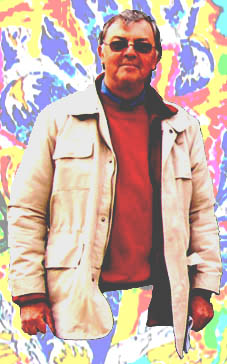Paul's Gemini star sign
may account for his attraction to contradictory styles: on the
one hand, the need to highlight the drawing itself, the graphic
skills; and on the other hand, the desire to paint freely without
formal constraint.
Culturally, the artist's interest in the first aspect stems
partly from a study of classicism, with its linear approach,
its confinement to formal limits and distinct plans; followed
by a more contemporary and more evident approach, derived from
comic strips.
The second aspect recalls the essential Baroque style: a more
pictorial approach, rejecting outlines, in search of connections;
as well as the more vivid, systematic approach, the indivisible
unity of informal contemporary art.
In 2003, the artist's output was sped up by an intuitive synthesis.
The acrylic canvas paintings are produced according to the following
successive stages:
o To start with, a sketch is drawn from a visual support on
one of various themes: landscapes, plants, characters, animals,
imaginary variations with humorous undertones, perhaps inspired
by Magritte.
o Followed by a deconstructive process which involves fragmenting
shapes, tending towards the abstract, in the wake of Picasso's
analytic cubism.
o These confined abstract shapes are then painted in a base
colour and outlined with a black border and are thus enhanced.
This reminds us of the spirit of the period in which “The
Divers” was painted by Fernand Léger, creator of
plastic contrast.
o The subsequent reconstructive process is applied to the remaining
defined open space by various techniques such as: the mixing
and overlaying of colour with a palette knife, the potential
use of a stencil; finishing off in the pointillist fashion,
in which the impressionists excelled, where the white spaces
set aside give birth to shimmering light.
Since 2008, this process has been enriched by the assembling
of fragments to add volume and render the final result more
intricate.
The artist's intuitive synthesis stems partly from a transposition
from the biological field, from the example of blood fluids.
While blood appears to be a unified substance, it is in fact
composed of clearly defined red and white cells floating in
plasma. This indefinite muddle gave rise to the analogy of plastic
construction.
Another source of inspiration is the psycho-physiological mechanism
of eyesight. In perceiving the world around us, we select -
no doubt somewhat subjectively - clearly defined real elements;
leaving the unperceived remaining spaces to form a blur, similar
to the abstract.
The artist's approach to his work is also of a dual nature:
combining a laborious constructive phase, calling on his intellect
and logic, with a phase of liberating, more spontaneous movement,
calling on his intuition.
